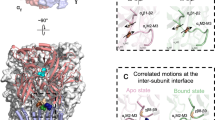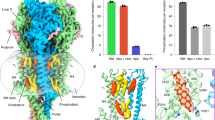Abstract
At the frog endplate, acetylcholine (ACh) causes depolarization by opening synaptic channels, and it is generally assumed that more than one molecule must bind to open one channel. This interpretation, proposed to explain the sigmoidicity of the dose–response curve1,2, also accounts for the potentiating effect of pipette-released ACh on the response to nerve-released ACh3. We have described a similar cross-potentiation between ACh and carbachol (CCh)4,5. The response to simultaneous application of these two agonists is larger than the sum of the responses to separate application, and we have assumed that this reflects the binding of both ACh and carbachol to individual receptor molecules. One approach to an understanding of the molecular basis of transmitter action is to study the mean time a channel remains open in its presence. Because this mean ‘Open time’ depends on the nature of the agonist used to activate a given receptor, we have measured this parameter in order to understand better the mechanism underlying the cross-potentiation. We compared the ‘Open times’ observed when the two agonists were applied separately with those obtained when both were applied together. In each case, when a ‘faster’ agonist (one inducing ‘short’ open times) and a ‘slower’ agonist (one inducing ‘long’ open times) are applied together, the channels opened by combined activation have a short mean open time, as if these were only controlled by the faster agonist.
This is a preview of subscription content, access via your institution
Access options
Subscribe to this journal
Receive 51 print issues and online access
$199.00 per year
only $3.90 per issue
Buy this article
- Purchase on Springer Link
- Instant access to full article PDF
Prices may be subject to local taxes which are calculated during checkout
Similar content being viewed by others
References
Katz, B. & Thesleff, S. J. Physiol., Lond. 138, 63–80 (1957).
Jenkinson, D. H. J. Physiol., Lond. 152, 309–324 (1960).
Hartzell, H. C., Kuffler, S. W. & Yoshikami, D. J. Physiol., Lond. 251, 427–463 (1975).
Feltz, A. & Trautmann, A. J. Physiol., Lond. 293, 64–65P (1979).
Feltz, A. & Trautmann, A. J. Physiol., Lond. 299, 533–552 (1980).
Katz, B. & Miledi, R. J. Physiol., Lond. 230, 707–717 (1973).
Magleby, K. L. & Stevens, C. F. J. Physiol., Lond. 223, 151–171 (1972).
Neher, E. & Sakman, B. Nature 260, 799–801 (1976).
Adams, P. R. Br. J. Pharmac. 53, 308–310 (1975).
Sheridan, R. E. & Lester, H. A. Proc. natn. Acad. Sci. U.S.A. 72, 3496–3500 (1975).
Neher, E. & Sakmann, B. Proc. natn. Acad. Sci. U.S.A. 72, 2140–2142 (1975).
Magazanik, L. G. & Vyskocil, F. J. Physiol., Lond. 249, 285–300 (1975).
Matthews-Bellinger, J. & Salpeter, M. M. J. Physiol., Lond. 279, 197–213 (1978).
Colquhoun, D. in The Receptors 1 (ed. O'Brien, R. D.) 93–142 (Plenum, New York, 1979).
Author information
Authors and Affiliations
Rights and permissions
About this article
Cite this article
Trautmann, A., Feltz, A. Open time of channels activated by binding of two distinct agonists. Nature 286, 291–293 (1980). https://doi.org/10.1038/286291a0
Received:
Accepted:
Issue Date:
DOI: https://doi.org/10.1038/286291a0
This article is cited by
-
Monoclonal antibodies modify acetylcholine-induced ionic channel properties in cultured chick myoballs
The Journal of Membrane Biology (1983)
Comments
By submitting a comment you agree to abide by our Terms and Community Guidelines. If you find something abusive or that does not comply with our terms or guidelines please flag it as inappropriate.



